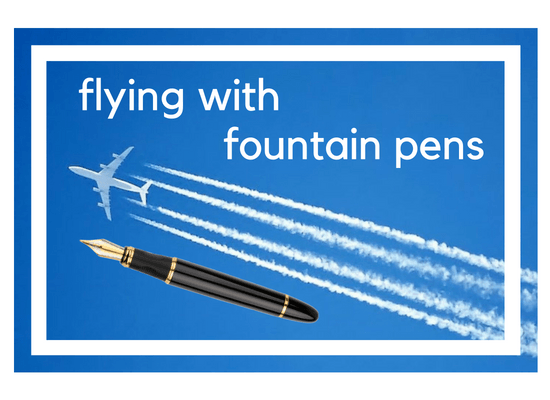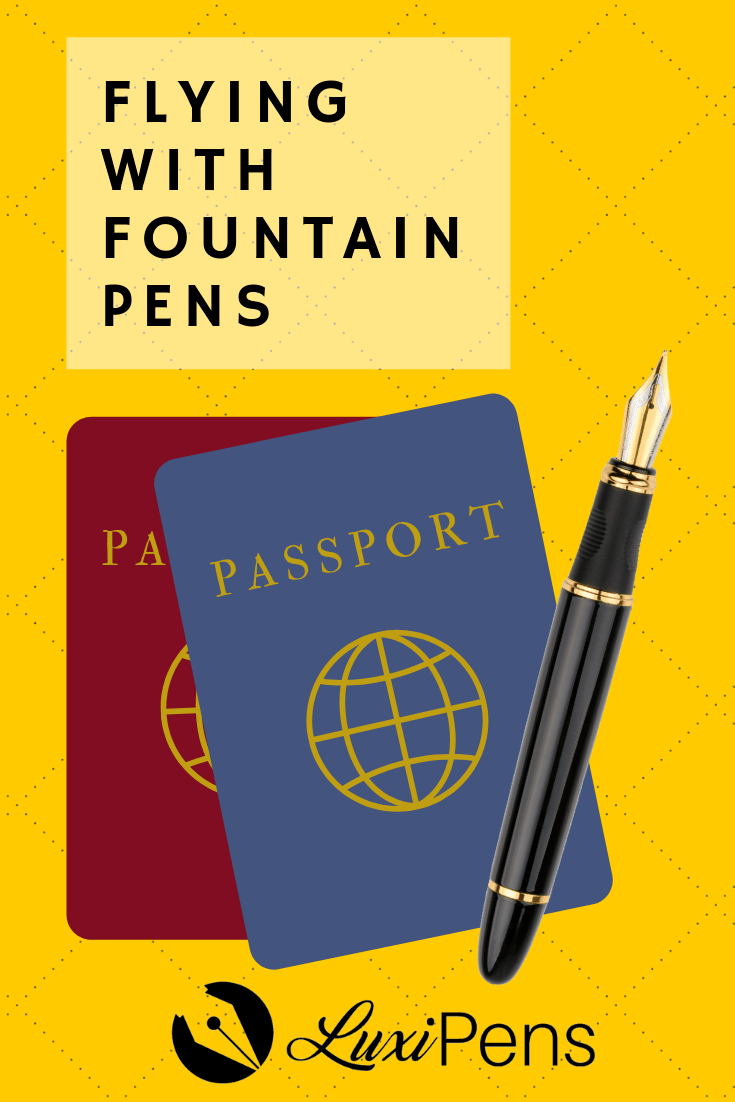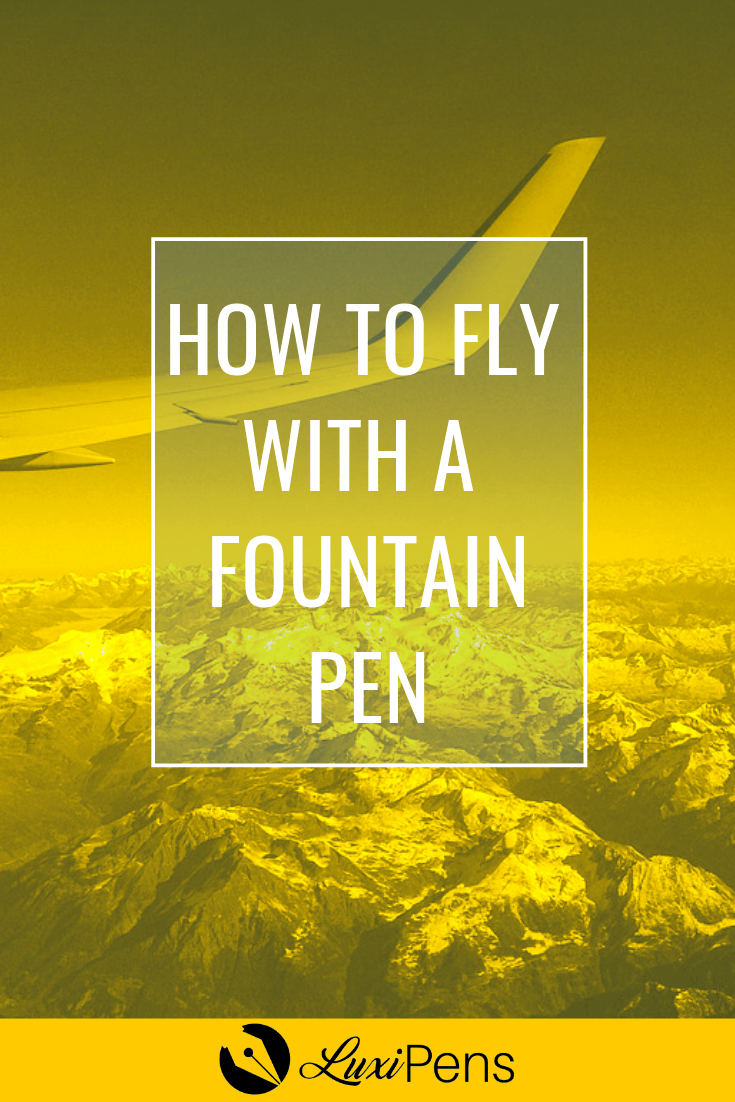Favorite book. Packed.
Favorite journal. Packed in the carry-on.
Favorite fountain pen to go with it? Wait! Can we bring fountain pens on airplanes?
Good question.
After all, fountain pens are known to leak on airplanes. And what about traveling with bottled ink or ink cartridges?
Flying with fountain pens can be a confusing affair. Below we’ve cleared up the answers when traveling with a fountain pen.
How to fly with a fountain pen
If you plan on flying with a fountain pen, there are three (3) simple options to protect both the pen (and your other belongings) during the flight:
How soon will you be traveling?
Time Until Travel | Preparation Method |
|---|---|
1 Day | Remove all ink from the pen, either by taking out the cartridge or draining the ink back into your inkwell. |
1 Week | Order a travel case or airtight cigar case to protect your other belongings if a leak occurs. |
1 Month | Shop for a pen with a removable cartridge so that you can completely remove the ink before you travel. |
This post contains affiliate links. See our disclosure page for more information.
1
Why do fountain pens leak at higher altitudes?
If you've ever traveled by plane before, you may have noticed that toothpaste, lotion, or liquid containers have exploded upon reopening. This same incident can also occur when using your fountain pen after air travel.
Boyle’s law explains the physics behind these incidents, as it states that the pressure acting on a container increases as the volume of the container decreases in order to balance internal and external pressure. What happens inside your pen during flight can explained by a simple process:
- 1The air pressure in a pressurized cabin is lower than the air pressure on the ground, where you last used the pen.
- 2Because most ink cartridges are not usually 100% full, there is air trapped within the pen that adjusts to match the external cabin pressure, which is lowering as you reach higher altitudes. Because of less pressure outside surrounding the pen, there is more internal air pressure building inside of the pen while in flight.
- 3Pen caps usually seal pens well, and so when they are opened after landing again, the feed is rapidly exposed to the new air pressure.
- 4The new, higher external pressure acts on the internal pressure of the pen, and the two forces work to balance each other. This is accomplished by the air inside the pen expanding and forcing the ink out to even out the external and internal pressure.
- 5As the pressure in the pen tries to meet equilibrium, the air pressure inside the pen rushes outward bringing a substantial amount of ink with it, resulting in leaks onto your hands and belongings.
2
How to Remove Ink Stains
When a fountain pen leaks, the ink often marks your hands, clothes, and belongings. These stains are not permanent, and they can be removed through some rather avant-garde methods. Hand sanitizer works in a pinch to treat an ink stain right away. Preventing stains from setting in is key to treating them effectively. If you do experience a leak, using hand sanitizer in combination with bleach will remove the stain:
- 1Apply hand sanitizer to the stain and scrub
- 2Wash the fabric in detergent with 1/2 cup bleach in the hottest water the fabric will allow
Note:
Only use this method on bleach-safe fabrics. Test your fabric on a hidden area (such as a hem) if you are unsure if your fabric is bleach-safe.
Bleach alternative:
If your fabric is not bleach-safe, try blotting the stain with small amounts of rubbing alcohol or dry cleaning solvent. After treating the stain with one of these solutions, wash with detergent in the warmest water the fabric will allow.
For more detailed information on ink stain removal, read our article:
“How to Remove Fountain Pen Ink From Hands”
3
Airplane Safe Pens
Before pressurized cabins, flying with fountain pens was riskier. To combat the issue of leaking instruments, some manufacturers developed leak-proof pens. Sheaffer released the “Skyboy” with the patented “Flo-Rite” curved ink canal feed during the 1930s. The company also claimed that the pens “self-adjusted” to atmospheric pressure changes, although this assertion was never corroborated. Today’s pens are less likely to leak due to the development of pressurized airplane cabins.
However, modern pens can still leak during ascent and descent, as cabins do not become pressurized until planes reach 6,000 feet. To prevent leaks, pen owners can purchase certain instruments that claim to be “airplane safe,” meaning that they will continue to work during flight. While there are not specific “airplane-safe” fountain pens, some rollerball pen manufacturers advertise that their products will continue to write during flight without leaking. Three of these pens are the Uni-ball Vision Elite, Pilot Precise V-ball Retractable Rollerball, and Fisher Space Pen.
*Note: Mobile devices - scroll right to see entire table.
Pen | Features |
|---|---|
While these pens may not provide the same joy as writing with a luxury fountain pen, they will work during flights without leaking.
4
Leak Proof Fountain Pens
If you desire to take a fountain pen on your next flight, there are a few safer options. While no fountain pen is completely leak-proof, most will not discharge if used correctly. Your best bet is a vacuum filler fountain pen, such as the Pilot Custom 823 or TWSBI’s Vac700R. These pens allow you to either completely drain the ink back into the inkwell or fill your pen up 100% more easily, making them a safer option for travel.
5
Emptying the Ink Cartridge from Your Fountain Pen
Pens with a disposable cartridge system are also good for flying, as the cartridge can be removed before traveling to prevent leaks. These pens also tend to be less expensive. Three options are the Pilot Metropolitan, Lamy Safari, and Cross Townsend 10KT Gold-Filled Fountain Pen.
*Note: Mobile devices - scroll right to see entire table.
Leak-Proof Fountain Pens | Features |
|---|---|
When traveling with one of these pens, removing the ink cartridge produces the best results. If there is no ink in your fountain pen, it will not leak. You can take out the cartridge in a few simple steps:
- 1Hold the pen horizontally and unscrew the body.
- 2With the nib facing up, carefully remove the ink cartridge from the nib and feed.
- 3Rinse the feed thoroughly to remove any excess ink before reassembling the pen.
- 4Save the ink that is still in the cartridge by pouring it back into your ink bottle.
For more information on How to Store A Fountain Pen for Travel, read our article:
“How to Store a Fountain Pen”
6
How to Fill a Fountain Pen (once you get there)
Once you arrive at your destination, you can easily refill your fountain pen using the following steps. The process of refilling a fountain pen varies depending on the filling system.
How to Install an Ink Cartridge
If you have a pen with a cartridge system:
- 1Unscrew the barrel to open the pen.
- 2Slide a new cartridge into the feed.
- 3Screw the pen back together. For some pens, this will pierce the cartridge. Other pens require that you press down on the cartridge to break the seal before replacing the barrel. Check your specific model’s instructions to discern how your pen works.
- 4Allow the nib to soak for a few minutes before using the pen.
How to Fill a Piston Converter Fountain Pen
If you have a piston converter fountain pen:
- 1Submerge the nib of the pen in the bottle of ink.
- 2Turn the converter counterclockwise to raise and lower the piston. You may need to do this several times for the pen to completely fill with ink.
- 3Clean the excess ink from the nib and reassemble the pen.
How to Fill a Lever Fill Fountain Pen
If you have a vintage pen with a lever filler system:
- 1Lift the lever out until it is perpendicular to the pen.
- 2Insert the nib into the ink bottle until fully submerged.
- 3Keeping the nib submerged, flick the lever back into the pen. Leave the nib submerged for at least ten seconds.
- 4Remove the pen from the ink bottle and wipe the nib clean.
For more detailed information on inking or charging a fountain pen, read our article:
“How to Put Ink in a Fountain Pen”
7
Fountain Pen Travel Cases
Packing your fountain pen in a travel case with the nib facing up at all times will safeguard your belongings from ink damage. These cases also offer an extra layer of protection for your pens by holding them in place, preventing your utensils from being jostled inside your luggage. Some fountain pen experts recommend the Visconti Dreamtouch case, which holds up to six pens.
Get your Visconti Dreamtouch here!
The Montblanc’s Meisterstück 1 pen sleeve is also popular because it is compact. You can purchase yours with this link.
Some pen owners prefer simple cloth pen wraps made from cotton or leather. They are less expensive, but may not protect your belongings. Another more effective and cheaper option for pen storage is an airtight cigar case. They prevent leaks by maintaining the pen’s internal pressure. Exploring one of the above options is good measure if you decide to carry your fountain pen in flight.
8
Traveling with Fountain Pen Ink
Many fountain pen owners also worry about transporting ink bottles, although they leak much less frequently than charged writing instruments. Once you open the bottle after landing, the pressure inside the bottle will equalize because the air inside the bottle is stored on top of the ink.
However, if you are traveling with an ink bottle in your carry-on, it must be under 100mL of liquid per TSA regulations if you are flying domestically within the United States. If you are packing glass ink bottles, wrap them carefully so they are not broken by things moving around in your carry-on or by careless baggage handlers. If you really want peace of mind, bubble wrap is the best wrapping choice, but a ziplock bag and a t-shirt are also effective.
9
Fountain Pen Ink Travel Bottle
If you want an ink bottle that is specifically for travel, the only one on the market is the Visconti Traveling Inkwell. Commonly called the Traveling Inkpot, it holds 5.5 mL of ink -- plenty for any vacation or business trip. Fountain pens with a grip that have a diameter about 9.2mm-13.2mm will fit in this inkwell. Visconti claims that nearly every pen can be filled using the Traveling Inkpot.
Whether traveling for work or leisure, you should not have to go without the pleasure of writing with your favorite fountain pen. By following these simple steps, you can bring your best instrument along without worry. Removing the ink from your pen is the most important step to ensuring a safe, leak-free flight. You can also buy fancy travel pouches for added protection, but airtight cigar cases work just as well. Next time you step on an airplane, remember these simple tips to ensure you are prepared for your trip with the best writing utensils possible.









